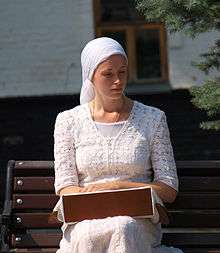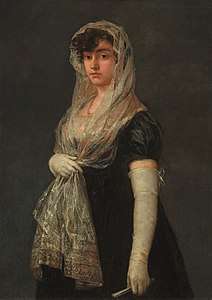Christian head covering
Christian head covering, also known as Christian veiling, is the practice of women covering their head in a variety of Christian traditions. Some Christian women, based on Orthodox, Roman Catholic, Anglican, Lutheran, Calvinist, and Methodist teaching, wear the head covering in public worship (though some women belonging to these traditions may also choose to wear the head covering outside of church),[1] while others, especially Anabaptist Christians, believe women should wear head coverings all the time.[2] The practice of Christian head covering for "praying and prophesying" was inspired by a traditional interpretation of 1 Corinthians 11:2–6 in the New Testament.[3] The practice of the Christian head covering for modesty is from Holy Oral Tradition; though, Saint Paul in 1 Corinthians 11:13-16 of Holy Scripture stated that a woman is to just have long hair for modesty. The majority of Biblical scholars have held that "verses 4-7 refer to a literal veil or covering of cloth" for "praying and prophesying" and verse 15 to refer to long hair of a woman for modesty.[4] Although the head covering was practiced by most Christian women until the latter part of the 20th century,[5] it is now a minority practice among contemporary Christians in the West, though it continues to be the normal practice in other parts of the world, such as Romania, Russia, Ukraine, Ethiopia, India, Pakistan, and South Korea.[6] The style of the Christian head covering varies by region.



History
Early Church
_(14596857218).jpg)
Christian head covering was unanimously practiced by the women of the Early Church. This was attested by multiple writers throughout the first centuries of Christianity. Clement of Alexandria (150–215), an early theologian, wrote, “Woman and man are to go to church decently attired...for this is the wish of the Word, since it is becoming for her to pray veiled.”[7] Clement of Alexandria (c. 150 – c. 215) writes about veiling, “It has also been commanded that the head should be veiled and the face covered, for it is a wicked thing for beauty to be a snare to men. Nor is it appropriate for a woman to desire to make herself conspicuous by using a purple veil.” The early Christian writer Tertullian (150–220) explains that in his day, the Corinthian church was still practicing head covering. This is only 150 years after the Apostle Paul wrote 1 Corinthians. He said, “So, too, did the Corinthians themselves understand [Paul]. In fact, at this day the Corinthians do veil their virgins. What the apostles taught, their disciples approve.”[8] Another theologian, Hippolytus of Rome (170–236) while giving instructions for church gatherings said "...let all the women have their heads covered with an opaque cloth..."[9] “Early church history bears witness that in Rome, Antioch, and Africa the custom [of wearing the head covering] became the norm [for the Church].”[10] Origen of Alexandria (c. 184 – c. 253) wrote, "There are angels in the midst of our assembly...we have here a twofold Church, one of men, the other of angels...And since there are angels present... women, when they pray, are ordered to have a covering upon their heads because of those angels. They assist the saints and rejoice in the Church." In the second half of the third century, women praying with their heads covered is mentioned as church practice by St. Victorinus in his commentary of the Apocalypse of John.[11]
Later, in the 4th century, the church leader John Chrysostom (347–407) stated, “…the business of whether to cover one’s head was legislated by nature (see 1 Cor 11:14–15). When I say “nature,” I mean “God.” For he is the one who created nature. Take note, therefore, what great harm comes from overturning these boundaries! And don’t tell me that this is a small sin.”[12] Jerome (347–420) noted that the hair cap and the prayer veil is worn by Christian women in Egypt and Syria: “do not go about with heads uncovered in defiance of the apostle’s command, for they wear a close-fitting cap and a veil.”[13] Augustine of Hippo (354–430) writes about the head covering, "It is not becoming, even in married women, to uncover their hair, since the apostle commands women to keep their heads covered."[14] Early Christian art also confirms that women wore headcoverings during this time period.[15]
Middle Ages and Early Modern Era

Until at least the 18th century, the wearing of a head covering, both in the public and while attending church, was regarded as customary for Christian women in Mediterranean, European, Middle Eastern, and African cultures.[16] A woman who did not wear a head covering was interpreted to be "a prostitute or adulteress.”[16][17] In Europe, law stipulated that married women who uncovered their hair in public was evidence of her infidelity.[18]
Current practices
Styles
| Region | Headpiece worn as Christian Headcovering | Image |
|---|---|---|
| Spain, Latin America, Eastern Europe, Russia | mantilla[19] |  |
| India, Pakistan | dupatta[20] | .jpg) |
| United States | bonnet (among many Anabaptists and Conservative Quakers), wide brim hats (in the American South)[21] |   |
Tradition
Eastern Christianity

Some Eastern Catholic, Eastern Orthodox and Oriental Orthodox Churches require women to cover their heads while in church; an example of this practice occurs in the Russian Orthodox Church.[22] In Albania, Christian women often wear white veils, although their eyes are visible; moreover, in that nation, in Orthodox Christian church buildings, women are separated from men by latticework partitions during the church service.[23]
In other cases, the choice may be individual, or vary within a country or jurisdiction. Among Eastern Orthodox women in Greece, the practice of wearing a head covering in church gradually declined over the course of the 20th century. In the United States, the custom can vary depending on the denomination and congregation, and the origins of that congregation. Catholics in South Korea still wear the headcovering.[6]
Eastern Orthodox clergy of all levels have head coverings, sometimes with veils in the case of monastics or celibates, that are donned and removed at certain points in the services. In U.S. churches they are less commonly worn.
Eastern Orthodox female monks wear a head covering called an apostolnik, which is worn at all times, and is the only part of the monastic habit which distinguishes them from Eastern Orthodox male monks.
Western Christianity
.jpg)

In Western Europe and North America at the start of the 20th century, women in some mainstream Christian denominations wore head coverings during church services.[24] These included many Anglican,[25] Baptist,[26] Catholic,[27] Lutheran,[28] Methodist,[29] Presbyterian Churches.[30][31][32]
Head covering for women was unanimously held by the Latin Church until the 1983 Code of Canon Law came into effect. Historically, women were required to veil their heads when receiving the Eucharist following the Councils of Autun and Angers.[33] Similarly, in 585, the Synod of Auxerre (France) stated that women should wear a head-covering during the Holy Mass.[34][35] The Synod of Rome in 743 declared that "A woman praying in church without her head covered brings shame upon her head, according to the word of the Apostle.,[36] a position later supported by Pope Nicholas I in 866, for church services."[37] In the Middle Ages, Thomas Aquinas (1225–1274) said that "the man existing under God should not have a covering over his to show he is immediately subject to God; but the woman should wear a covering to show that besides God she is naturally subject to another."[38] In the 1917 Code of Canon Law it was a requirement that women cover their heads in church. It said, "women, however, shall have a covered head and be modestly dressed, especially when they approach the table of the Lord."[39] Veiling was not specifically addressed in the 1983 revision of the Code, which declared the 1917 Code abrogated.[40] According to the new Code, former law only has interpretive weight in norms that are repeated in the 1983 Code; all other norms are simply abrogated. There is no provision made for norms that are not repeated in the 1983 Code.[41]
Martin Luther, the Protestant Reformer, encouraged wives to wear a veil in public worship.[42] The General Rubrics of the Evangelical Lutheran Synodical Conference of North America, as contained in "The Lutheran Liturgy", state in a section titled "Headgear for Women": "It is laudable custom, based upon a Scriptural injunction (1 Cor. 11:3-15), for women to wear an appropriate head covering in Church, especially at the time of divine service."[28]
John Calvin, the founder of the Reformed Churches and John Knox, the founder of the Presbyterian Church, both called for women to wear head coverings in public worship.[30][31][32] John Wesley, the founder of Methodism, held that a woman, "especially in a religious assembly", should "keep on her veil".[43][44][44]
In nations in regions such as Eastern Europe and the Indian subcontinent, nearly all Christian women wear head coverings during church services.[45][46] In the United Kingdom, it is common for women to wear a Christian headcovering while attending formal religious services, such as church weddings.[47][48][49] At worship, in parts of the Western World, many women started to wear bonnets as their headcoverings, and later, hats became predominant.[50][51] However, eventually, in North America and parts of Western Europe, this practice started to decline,[24][52] with some exceptions including Christians who wear plain dress, such as Conservative Quakers and many Anabaptists (including Mennonites, Hutterites,[53] Old German Baptist Brethren,[54] Apostolic Christians and Amish). Moravian females wear a lace headcovering called a haube, especially when serving as dieners.[55] Traditionalist Catholics, as well as many Holiness Christians who practice the doctrine of outward holiness, also practice headcovering,[56] in addition to the Laestadian Lutheran Church, the Plymouth Brethren, and the more conservative Scottish and Irish Presbyterian and Dutch Reformed churches. Some female believers in the Churches of Christ cover too. Pentecostal Churches, such as the Church of Our Lord Jesus Christ of the Apostolic Faith, The Pentecostal Mission, the Christian Congregation, and Believers Church observe the veiling of women as well.[57] Female members of Jehovah's Witnesses may only lead prayer and teaching when no baptized male is available to, and must do so wearing a head covering.[58][59]
Nuns of the Roman Catholic, Lutheran and Anglican traditions often wear a veil as a part of their religious habit.
Oriental Christianity
_-_TIMEA.jpg)
Coptic women historically covered their head and face in public and in the presence of men.[60] During the 19th century, upper-class urban Christian and Muslim women in Egypt wore a garment which included a head cover and a burqa (muslin cloth that covered the lower nose and the mouth).[61] The name of this garment, harabah, derives from early Christian and Judaic religious vocabulary, which may indicate the origins of the garment itself.[61] Unmarried women generally wore white veils while married women wore black.[60] The practice began to decline by the early 20th century.[60]
Scriptural basis


Christian Bible/Old Testament
Passages such as Genesis 24:65, Numbers 5:18 and Isaiah 47:2 indicate that some women wore a head covering during the Old Testament time period.
Christian Bible/New Testament

1 Corinthians 11:2–16 contains the only passage in the New Testament referring to the use of headcoverings for women (and the uncovering of the heads of men).[3][62]
Paul introduces this passage by praising the Corinthian Christians for remembering the "teachings" (also translated as "traditions"[63] or "ordinances"[64]) that he had passed on to them (verse 2).
Paul then explains the Christian use of head coverings using the subjects of headship, glory, angels, natural hair lengths, and the practice of the churches. What he specifically said about each of these subjects has led to differences in interpretation (and practice) among Bible commentators and Christian congregations.
Relevant texts
I praise you for remembering me in everything and for holding to the traditions just as I passed them on to you. But I want you to realize that the head of every man is Christ, and the head of the woman is man, and the head of Christ is God. Every man who prays or prophesies with his head covered dishonors his head. But every woman who prays or prophesies with her head uncovered dishonors her head—it is the same as having her head shaved. For if a woman does not cover her head, she might as well have her hair cut off; but if it is a disgrace for a woman to have her hair cut off or her head shaved, then she should cover her head.
A man ought not to cover his head, since he is the image and glory of God; but woman is the glory of man. For man did not come from woman, but woman from man; neither was man created for woman, but woman for man. It is for this reason that a woman ought to have authority over her own head, because of the angels. Nevertheless, in the Lord woman is not independent of man, nor is man independent of woman. For as woman came from man, so also man is born of woman. But everything comes from God.
Judge for yourselves: Is it proper for a woman to pray to God with her head uncovered? Does not the very nature of things teach you that if a man has long hair, it is a disgrace to him, but that if a woman has long hair, it is her glory? For long hair is given to her as a covering. If anyone wants to be contentious about this, we have no other practice — nor do the churches of God.
— 1 Corinthians 11:2-16, New International translation
Some combine this it with 1 Thessalonians 5 ("Rejoice always; pray without ceasing; in everything give thanks; for this is God’s will for you in Christ Jesus. Do not quench the Spirit; do not despise prophetic utterances"[65]) and hold that Christian women are commanded to wear the Christian head covering without ceasing.[66]
It is also sometimes interpreted in conjunction with modesty in clothing (1 Timothy 2:9-10 "I also want the women to dress modestly, with decency and propriety, adorning themselves, not with elaborate hairstyles or gold or pearls or expensive clothes, but with good deeds, appropriate for women who profess to worship God"[67]).
Interpretive issues
There are several key sections of 1 Corinthians 11:2–16 that Bible commentators and Christian congregations have held differing opinions about, which have resulted in a diversity of practices regarding the use of headcoverings.
- Gender-based headship: Paul connects the use (or non-use) of headcoverings with the biblical distinctions between each gender. In 1 Corinthians 11:3, Paul wrote, “Christ is the head of every man, and the man is the head of a woman." He immediately continues with a gender-based teaching on the use of headcoverings: "Every man who has something on his head while praying or prophesying disgraces his head. But every woman who has her head uncovered while praying or prophesying disgraces her head."
- Glory and worship: Paul next explains that the use (or non-use) of headcoverings is related to God's glory during times of prayer and prophesy. In 1 Corinthians 11:7, he states that man is the "glory of God" and that for this reason "a man ought not to have his head covered." In the same verse, Paul also states that the woman is the "glory of man." He explains that statement in the subsequent two verses by referring to the woman's creation in NASB, and then concludes, "Therefore the woman ought to have a symbol of authority on her head" (verse 10). In other words, the "glory of God" (man) is to be uncovered during times of worship, while the "glory of man" (woman) is to be covered.
- Angels: In 1 Corinthians 11:10, Paul says “Therefore the woman ought to have a symbol of authority on her head, because of the angels.” Many interpreters admit that Paul does not provide much explanation for the role of angels in this context. Some popular interpretations of this passage are (1) An appeal not to offend the angels by disobedience to Paul's instructions, (2) a command to accurately show angels a picture of the created order (Ephesians 3:10, 1 Peter 1:12), (3) a warning for us to obey as a means of accountability, since the angels are watching (1 Timothy 5:21), (4) to be like the angels who cover themselves in the presence of God (Isaiah 6:2), and (5) not to be like the fallen angels who did not stay in the role that God created for them (Jude 1:6).
- Nature and hair lengths: In 1 Corinthians 11:13–15, Paul asks a rhetorical question about the propriety of headcoverings, and then answers it himself with a lesson from nature: “Judge for yourselves: is it proper for a woman to pray to God with her head uncovered? Does not even nature itself teach you that if a man has long hair, it is a dishonor to him, but if a woman has long hair, it is a glory to her? For her hair is given to her for a covering.” In this passage, some see Paul as indicating that since a woman naturally "covers" her head with long hair, she likewise ought to cover it with a cloth covering while praying or prophesying. Others interpreters see the statement "her hair is given to her for a covering" as indicating that all instances of headcovering in the chapter refer only to the "covering" of long hair.
- Church practice: In 1 Corinthians 11:16, Paul responded to any readers who may disagree with his teaching about the use of headcoverings: “But if one is inclined to be contentious, we have no other practice, nor have the churches of God.” This may indicate that headcoverings were considered a standard, universal Christian symbolic practice (rather than a local cultural custom). In other words, while Christian churches were spread out geographically and contained a diversity of cultures, they all practiced headcovering for female members.
Interpretive conclusions and resulting practices
Due to various interpretive issues (such as those listed above), Bible commentators and Christian congregations have a diversity of conclusions and practices regarding headcovering. One primary area of debate is whether Paul's call for men to uncover their heads and women to cover their heads was intended to be followed by Christians outside of the First Century Corinthian church. While some Christian congregations continue to use headcoverings for female members, others do not.
- Some churches view Christian headcovering as a practice that Paul intended for all Christians, in all locations, during all time periods and so they continue the practice within their congregations. They base their interpretation on the God-ordained order of headship,[68]
- Another interpretation is that Paul's commands regarding headcovering were a cultural mandate that was only for the first-century Corinthian church. Often, interpreters will state that Paul was simply trying to create a distinction between uncovered Corinthian prostitutes and godly Corinthian Christian women. Under that interpretation, a church will not practice Christian headcovering.
- Some Christians believe that Paul stated that long hair is the covering, when it comes to modesty (see 1 Corinthians 11:14–15).[69] Feminist theologian Katharine Bushnell provides another interpretation that similarly teaches that Paul was not intending for women to cover their hair with a cloth covering, for modesty.[70]
The majority of Biblical scholars have held that "verses 4-7 refer to a literal veil or covering of cloth" for "praying and prophesying" and verse 15 to refer to long hair of a woman for modesty.[71]
See also
- Coif
- Complementarianism
- First Corinthians
- Headscarf
- Kerchief
- Ordinance
- Plain dress
- Tichel, Orthodox Jewish headcovering
- Veil
References
- Witherington III, Ben (1995). Conflict and Community in Corinth: A Socio-Rhetorical Commentary on 1 and 2 Corinthians. Eerdmans. p. 236.
“Paul’s view is that the creation order should be properly manifested, not obliterated, in Christian worship, especially because even angels, as guardians of the creation order, are present, observing such worship and perhaps even participating in it."
- Hole, Frank Binford. "F. B. Hole's Old and New Testament Commentary". StudyLight. Retrieved 6 February 2016.
“There is no contradiction between 1 Corinthians 11:5 of our chapter and 1 Corinthians 14:34, for the simple reason that there speaking in the assembly is in question, whereas in our chapter the assembly does not come into view until verse 1 Corinthians 11:17 is reached. Only then do we begin to consider things that may happen when we “come together.” The praying or prophesying contemplated in verse 1 Corinthians 11:5 is not in connection with the formal assemblies of God’s saints.”
- Osburn, Carroll D. (1 July 2007). Essays on Women in Earliest Christianity, Volume 1. Wipf and Stock Publishers. p. 208. ISBN 9781556355400.
- Bernard, David (1985). "Practical Holiness". Word Aflame Press. Missing or empty
|url=(help) - Earle, Alice Morse (1903). Two Centuries of Costume in America, Vol. 2 (1620–1820). The Macmillan Company. p. 582.
“One singular thing may be noted in this history, – that with all the vagaries of fashion, woman has never violated the Biblical law that bade her cover her head. She has never gone to church services bareheaded.”
- "Easter conversions confirm South Korean Church's striking growth :: EWTN News". www.ewtnnews.com. Archived from the original on 2012-06-16.
- Clement of Alexandria. (1885). The Instructor. In A. Roberts, J. Donaldson, & A. C. Coxe (Eds.), Fathers of the Second Century: Hermas, Tatian, Athenagoras, Theophilus, and Clement of Alexandria (Entire) (Vol. 2, p. 290). Buffalo, NY: Christian Literature Company.
- Tertullian. (1885). On the Veiling of Virgins. In A. Roberts, J. Donaldson, & A. C. Coxe (Eds.), S. Thelwall (Trans.), Fathers of the Third Century: Tertullian, Part Fourth; Minucius Felix; Commodian; Origen, Parts First and Second (Vol. 4, p. 33). Buffalo, NY: Christian Literature Company.
- Hippolytus, and Easton, B. (1934). The Apostolic tradition of Hippolytus. New York: Macmillan, p.43.
- Johnson, Lewis (1962). The Wycliffe Bible Commentary. Chicago: Moody Press. pp. 1247–1248.
- Head Covering in First Christianity – Context, AnonymousChristian, retrieved December 5, 2018
- L. Kovacs, Judith (2005). The Church's Bible (1 Corinthians). Wm. B. Eerdmans Publishing. p. Page 180.
- Jerome. (1893). The Letters of St. Jerome. In P. Schaff & H. Wace (Eds.), W. H. Fremantle, G. Lewis, & W. G. Martley (Trans.), St. Jerome: Letters and Select Works (Vol. 6, p. 292). New York: Christian Literature Company.
- Augustine of Hippo. (1886). Letters of St. Augustin. In P. Schaff (Ed.), J. G. Cunningham (Trans.), The Confessions and Letters of St. Augustin with a Sketch of His Life and Work (Vol. 1, p. 588). Buffalo, NY: Christian Literature Company.
- Bercot, David. "Head Covering Through the Centuries". Scroll Publishing. Retrieved 28 April 2016.
- Hunt, Margaret (11 June 2014). Women in Eighteenth Century Europe. Taylor & Francis. p. 58. ISBN 9781317883876.
- Safran, Linda (21 March 2014). The Medieval Salento: Art and Identity in Southern Italy. University of Pennsylvania Press. p. 112. ISBN 9780812245547.
- Weitz, Rose (12 January 2005). Rapunzel's Daughters: What Women's Hair Tells Us About Women's Lives. Farrar, Straus and Giroux. p. 20. ISBN 9781429931137.
- The Pacific, Volume 50. J.W. Douglas. 1901. p. 227.
- Flinn, Isabella (1 May 2014). Pinpricks in the Curtain: India Through the Eyes of an Unlikely Missionary. WestBow Press. p. 234. ISBN 9781490834313.
- "What are Church Hats?". Southern Living. Retrieved 14 January 2018.
- Gdaniec, Cordula (1 May 2010). Cultural Diversity in Russian Cities: The Urban Landscape in the Post-Soviet Era. Berghahn Books. p. 161. ISBN 9781845456658. Retrieved 27 October 2012.
According to Russian Orthodox tradition women cover their heads when entering a church.
- Edwin E. Jacques (1995). The Albanians: An Ethnic History from Prehistoric Times to the Present. McFarland. p. 221. ISBN 978-0899509327. Retrieved 27 October 2012.
Poujade (1867, 194) noted that Christian women frequently used white veils. Long after independence from Turkey, elderly Orthodox women in Elbasan could be seen on the street wearing white veils, although usually their eyes were visible. Turkish influence upon the Christian community is seen also in latticework partitions in the rear of the Orthodox churches, the women being kept behind the screen during mass.
- Kraybill, Donald B. (5 October 2010). Concise Encyclopedia of Amish, Brethren, Hutterites, and Mennonites. JHU Press. p. 103. ISBN 9780801896576. Retrieved 13 November 2012.
During the 20th century, the wearing of head coverings declined in more assimilated groups, which gradually interpreted the Pauline teaching as referring to cultural practice in the early church without relevance for women in the modern world. Some churches in the mid-20th century had long and contentious discussions about wearing head coverings because proponents saw its decline as a serious erosion of obedience to scriptural teaching.
- Muir, Edward (18 August 2005). Ritual in Early Modern Europe. Cambridge University Press. p. 31. ISBN 9780521841535. Retrieved 13 November 2012.
In England radical Protestants, known in the seventeenth century as Puritans, we especially ardent in resisting the churching of women and the requirement that women wear a head covering or veil during the ceremony. The Book of Common Prayer, which became the ritual handbook of the Anglican Church, retained the ceremony in a modified form, but as one Puritan tract put it, the "churching of women after childbirth smelleth of Jewish purification."
- Yearbook of American & Canadian Churches 2012. Abingdon Press. 2012-04-01. p. 131. ISBN 9781426746666. Retrieved 13 November 2012.
The holy kiss is practiced and women wear head coverings during prayer and worship.
- Henold, Mary J. (2008). Catholic and Feminist: The Surprising History of the American Catholic Feminist Movement. UNC Press Books. p. 126. ISBN 9780807859476. Retrieved 13 November 2012.
At that time, official practice still dictated that Catholic women cover their heads in church.
- The Lutheran Liturgy: Authorized by the Synods Constituting The Evangelical Lutheran Synodical Conference of North America. St. Louis: Concordia Publishing House. 1941. p. 427.
- Morgan, Sue (2010-06-23). Women, Gender and Religious Cultures in Britain, 1800–1940. Taylor & Francis. p. 102. ISBN 9780415231152. Retrieved 13 November 2012.
Several ardent Methodist women wrote to him, asking for his permission to speak. Mar Bosanquet (1739–1815) suggested that if Paul had instructed women to cover their heads when they spoke (1. Cor. 11:5) then he was surely giving direction on how women should conduct themselves when they preached.
- John Knox, "The first blast of the trumpet against the monstruous regiment of women", Works of John Knox, David Laing, ed. (Edinburgh: Printed for the Bannatyne Club), IV:377
- Seth Skolnitsky, trans., Men, Women and Order in the Church: Three Sermons by John Calvin (Dallas, TX: Presbyterian Heritage Publications, 1992), pp. 12,13.
- Commentary on 1 Corinthians 11:2–16 (and related passages) Archived 2015-09-23 at the Wayback Machine
- McClintock, John; Strong, James (1891). Cyclopaedia of Biblical, Theological and Ecclesiastical Literature. Harper & Bros. p. 739.
A white veil or coif, called velamen dominicale, was worn by females at the time of receiving the eucharist during the 5th and 6th centuries These veils were ordered by the councils of Autun 578 and Angers.
- "The Liturgy and Ritual of the Celtic Church". The Church Quarterly Review. 10: 78. 1880.
- Schmidt, lvin (1989). Veiled and Silenced. Mercer University Press. p. 136.
- Synod of Rome (Canon 3). Giovanni Domenico Mansi, Sacrorum Conciliorum Nova et Amplissima Collectio (Page 382)
- Schmidt, Alvin (1989). Veiled and Silenced. Mercer University Press. p. 136.
- Aquinas, Thomas. "Super I Epistolam B. Pauli ad Corinthios lectura". Dominican House of Studies. Retrieved 1 August 2016.
- Peters, Edward (2001). The 1917 Pio-Benedictine Code of Canon Law. Ignatius Press. p. 427.
- Canon 6 of the 1983 Code of Canon Law
- Canon 6, section 2 of the 1983 Code of Canon Law
- Susan C. Karant-Nunn, Merry E. Wiesner, ed. (2003-03-13). Luther on Women: A Sourcebook. Cambridge University Press. p. 31. ISBN 9780521658843.
Otherwise and aside from that, the wife should put on a veil, just as a pious wife is duty-bound to help bear her husband's accident, illness, and misfortune on account of the evil flesh.
- Wesley, John (1987). Wesley's Notes on the Bible. Christian Classics Ethereal Library. p. 570. ISBN 9781610252577.
Therefore if a woman is not covered — If she will throw off the badge of subjection, let her appear with her hair cut like a man's. But if it be shameful far a woman to appear thus in public, especially in a religious assembly, let her, for the same reason, keep on her veil.
- Dunlap, David (1 November 1994). "Headcovering-A Historical Perspective". Uplook Ministries. Retrieved 24 June 2019.
Although women were allowed to preach in the Methodist ministry, the veil covering a woman’s head was required as a sign of her headship to Christ. Concerning the theological significance of the veil, Wesley wrote, “For a man indeed ought not to veil his head because he is the image and glory of God in the dominion he bears over the creation, representing the supreme dominion of God, which is his glory. But the woman is a matter of glory to the man, who has a becoming dominion over her. Therefore she ought not to appear except with her head veiled as a tacit acknowledgement of it.”
- Reagan, David R. (1 January 1994). Trusting God: Learning to Walk by Faith. Lamb & Lion Ministries. p. 164. ISBN 9780945593034.
One thing that fascinated me about the Eastern European churches was the "sea of white" that I saw every time I got up to preach. This was due to the fact that most of the churches practiced head covering for women.
- Haji, Nafisa (2011-05-17). The Sweetness of Tears. HarperCollins. p. 316. ISBN 9780061780103. Retrieved 13 November 2012.
I went to church, something I'd never expected to do in Pakistan. Sadiq told me that his grandfather's nurse, Sausan, was Christian. Presbyterian. My second Sunday in Karachi, I went to services with her. I was glad of the clothese that Haseena Auntie had helped me shop for, because all the women in church covered their heads, just like Muslim women, with their dupattas.
- Barrett, Colleen (21 February 2011). "Why Do British Women Wear Hats to Weddings?". PopSugar. Retrieved 14 January 2018.
- Cathcart, Laura (25 May 2017). "A milliner's guide to wearing hats in church". The Catholic Herald. Archived from the original on 14 January 2018. Retrieved 14 January 2018.
- Hodgkin, Emily (29 January 2018). "Kate Middleton to be forced to do this at Meghan Markle and Prince Harry's wedding?". Daily Express. Retrieved 20 May 2018.
However, as the Royal Family are known to be sticklers for tradition, hats will no doubt be required for Harry’s wedding. The wearing hats to church by all women is traditionally a requirement of the Anglican church. This is due to the writing of St Paul in Corinthians, where he has some pretty strong feelings about women wearing hats. In 1 Corinthians 11:1-34 he said: “I want you to understand that the head of every man is Christ, the head of a wife is her husband, and the head of Christ is God. “Every man who prays or prophesies with his head covered dishonours his head, but every wife who prays or prophesies with her head uncovered dishonours her head, since it is the same as if her head were shaven.”
- Courtais, Georgine De (1 February 2006). Women's Hats, Headdresses And Hairstyles: With 453 Illustrations, Medieval to Modern. Courier Dover Publications. p. 130. ISBN 9780486448503. Retrieved 13 November 2012.
Although hats were not considered sufficiently respectable for church wear and very formal occasions they were gradually taking the place of bonnets, at least for younger women.
- Mark, Rebecca; Vaughan, Robert C. (2004). The South. Greenwood Publishing Group. p. 175. ISBN 9780313327346. Retrieved 13 November 2012.
The red and orange turban described by the anonymous observer also looks forward to the flamboyant Sunday hats worn by African American middle-class women into the twenty-first century, hats celebrated stunningly by Michael Cunningham and Graig Marberry in Crowns: Portraits of Black Women in Church Hats.
- Elisabeth, Hallgren Sjöberg (24 September 2017). "Såsom en slöja : Den kristna slöjan i en svensk kontext". Diva.
- Hostetler, John (1997). Hutterite Society. The Johns Hopkins University Press. p. 105. ISBN 978-0-8018-5639-6.
- Thompson, Charles (2006). The Old German Baptist Brethren: Faith, Farming, and Change in the Virginia Blue Ridge. University of Illinois Press. p. 33. ISBN 978-0-252-07343-4.
- Crump, William D. (30 August 2013). The Christmas Encyclopedia, 3d ed. McFarland. p. 298. ISBN 9781476605739.
- DeMello, Margo (14 February 2012). Faces around the World. ABC-CLIO. p. 303. ISBN 9781598846188. Retrieved 13 November 2012.
- "About Believers Church: Practical Distinctives". Gospel for Asia. Retrieved 31 July 2016.
In our church services, you will see that the women wear head coverings as is mentioned in 1 Corinthians 11:2–16. In the same way, we adhere to the practice of baptism as commanded in Matthew 28:19, and Holy Communion, which is given to us in 1 Corinthians 11:23–26. These are all part of the traditions of faith of Believers Church.
- "Head Coverings—When and Why?". Keep Yourselves in God's Love. Watch Tower. 2008. pp. 209–12.
- "Questions From Readers", The Watchtower, July 15, 2002, page 27.
- Sir Ernest Alfred Wallis Budge (1902). The Nile: Notes for Travellers in Egypt. T. Cook & Son, (Egypt). p. 207.
- El Guindi, Fadwa; Sherifa Zahur (2009). Hijab. The Oxford Encyclopedia of the Islamic World. doi:10.1093/acref/9780195305135.001.0001. ISBN 9780195305135.
- Safran, Linda (21 March 2014). The Medieval Salento: Art and Identity in Southern Italy. University of Pennsylvania Press. p. 112. ISBN 9780812245547.
Many Christian women also covered their hair, as enjoined by Saint Paul (1 Cor. 11:5) and as suggested by numerous medieval representations.
- "Paradosis – New Testament Lexicon". Paradosis – New Testament Lexicon – New American Standard. Retrieved 31 July 2016.
- "1 Corinthians 11:2 – KJV". 1 Corinthians 11:2 – KJV. Retrieved 31 July 2016.
- "Bible Gateway passage: 1 Thessalonians 5 - New American Standard Bible".
- The Brethren Encyclopedia. Brethren Encyclopedia, Incorporated. 1983. p. 1062.
- "Bible Gateway passage: 1 Timothy 2 - New International Version".
- MacDonald, William (1995). Believer's Bible Commentary. Nashville, TN: Thomas Nelson Publishers. p. 1786. ISBN 9780840719720.
Paul teaches the subordination of the woman to man by going back to creation. This should forever lay to rest any idea that his teaching about women's covering was what was culturally suitable to his day but not applicable to us today.
- Merkle, Ben. "Headcoverings and Modern Women". Archived from the original on January 3, 2011.
- Bushnell, Katharine (1921). God's Word to Women. Minneapolis, MN: Christians for Biblical Equality. ISBN 978-0-9743031-0-9.
- Bernard, David (1985). "Practical Holiness". Word Aflame Press. Missing or empty
|url=(help)
Further reading
- Gardiner, Jeremy (2016). Head Covering: A Forgotten Christian Practice For Modern Times. Head Covering Movement. ISBN 978-1939770226.
- Henderson, Warren (2013). Glories Seen & Unseen: A Study of the Head Covering. ISBN 978-0995203600.
- Sanseri, Gary (1999). Covered or Uncovered? How 1 Corinthians 11:2–16 applies to worship and leadership in the church. Back Home Industries. ISBN 978-1880045206.
- Morris, Leon (1985). "The Veiling of Women". The First epistle of Paul to the Corinthians. Grand Rapids: Eerdmans. pp. 148–55. ISBN 978-0-8028-0064-0.
- Fee, Gordon D. (1987). "Women (and Men) in Worship". The First Epistle to the Corinthians. New International Commentary on the New Testament. Grand Rapids: Eerdmans. pp. 491–530. ISBN 978-0-8028-2507-0.
- Martin, Troy W. (2004). "Paul's Argument from Nature for the Veil in 1 Corinthians 11:13–15: A Testicle Instead of a Head Covering" (PDF). Journal of Biblical Literature. 123 (1): 75–84. doi:10.2307/3268550. JSTOR 3268550.
- Murphy-O'Connor, Jerome (1976). "The Non-Pauline Character of 1 Corinthians 11:2-16?" (PDF). Journal of Biblical Literature. 95 (4): 615–21. doi:10.2307/3265576. JSTOR 3265576.
- Walker, WM. O. (1975). "1 Corinthians 11:2–16 and Paul's Views regarding Women". Journal of Biblical Literature. 94 (1): 94–110. doi:10.2307/3266038. JSTOR 3266038.
- Powers, Janet E. (2001). "Recovering a Woman's Head with Prophetic Authority: A Pentecostal Interpretation of 1 Corinthians 11.3–16". Journal of Pentecostal Theology. 10: 11–37. doi:10.1177/096673690101000102.
- Fitzmyer, Joseph A. (2009). "Another Look at KeΦaΛh in 1 Corinthians 11.3". New Testament Studies. 35 (4): 503–11. doi:10.1017/S0028688500015174.
- Hooker, M. D. (2009). "Authority on her Head: An Examination of I Cor. xi. 10". New Testament Studies. 10 (3): 410–6. doi:10.1017/S0028688500024334.
- Scroggs, Robin (1972). "Paul and the Eschatological Woman". Journal of the American Academy of Religion (3): 283–303. doi:10.1093/jaarel/XL.3.283.
- Goodacre, Mark (2011). "Does περιβόλαιоν Mean 'Testicle' in 1 Corinthians 11:15?" (PDF). Journal Journal of Biblical Literature. 130 (2): 391–6. doi:10.2307/41304207. hdl:10161/7976. JSTOR 41304207.
- Shoemaker, Thomas R (1987). "Unveiling of Equality: 1 Corinthians 11:2–16". Biblical Theology Bulletin. 17 (2): 60–3. doi:10.1177/014610798701700204.
- Gill, David W. J. (1990). "The Importance of Roman Portraiture for Head-Coverings in 1 Corinthians 11:2–16" (PDF). Tyndale Bulletin. 41 (2): 245–60.
- Massey, Preston T. (2011). "Long Hair as a Glory and as a Covering: Removing an Ambiguity from 1 Cor 11:15". Novum Testamentum. 53: 52–72. doi:10.1163/004810010X12590258025980.
- Massey, Preston T. (2007). "The Meaning of κατακαλυπτω and κατα κεφαλης εχων in 1 Corinthians 11.2–16". New Testament Studies. 53 (4): 502–23. doi:10.1017/S0028688507000252.
- Oster, Richard (2009). "When Men Wore Veils to Worship: The Historical Context of 1 Corinthians 11.4". New Testament Studies. 34 (4): 481–505. doi:10.1017/S0028688500021093.